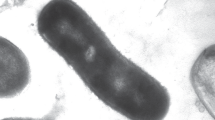Abstract
The dominant purple sulfur bacterium of a reddish-colored waste water pond near Taichung, Taiwan, was isolated in pure culture, strain CML2. Individual cells were nearly spherical, nonmotile, and contained in their peripheral parts was vacuoles that appeared like elongated, curved tubes. Four to sixteen cells formed platelet-like aggregates reminiscent of Thiopedia rosea. The intracellular photosynthetic membrane system of the cells was of vesicular type; the photosynthetic pigments consisted of bacteriochlorophyll a and spirilloxanthin as the major carotenoid. The color of cell suspensions was pink to rosered. Under anaerobic conditions photolithoautotrophic growth occurred with sulfide, elemental sulfur or thiosulfate; sulfur globules were stored as an intermediary oxidation product. In the presence of sulfide, acetate, lactate and pyruvate were photoassimilated; strain CML2 lacked assimilatory sulfate reduction. Fastest photoautotrophic growth (11 h doubling time) was obtained at pH 7.5, 35°C and a light intensity of about 1000 lux (tungsten lamp). Chemolithoautotrophic growth in the dark was possible under reduced oxygen partial pressure with reduced sulfur compounds as respiratory substrates. The DNA base composition of strain CML2 was 65.5 mol% G+C. Strain CML2 is described as type strain of a new species, Amoebobacter pedioformis sp. nov., in the family Chromatiaceae.
Similar content being viewed by others
References
Bavendamm W (1924) Die farblosen und roten Schwefelbakterien des Süß-und Salzwassers. In: Kolkowitz R (ed) Pflanzenforschung, Heft 2. Fischer, Jena, pp 1–157
Caumette P, Schmidt K, Biebl H, Pfennig N (1985) Characterization of a Thiocapsa strain containing okenone as major carotenoid. Syst Appl Microbiol 6:132–136
Caumette P, Schmidt K, Biebl H Pfennig N (1985) Characterization of a Thiocapsa strain containing okenone as major carotenoid. Syst Appl Microbiol 6:132–136
Clayton RK (1963) Towards the isolation of a photochemical reaction center in Rhodopseudomonas spheroides. Biochim Biophys Acta 75:312–317
Cohen-Bazire G, Sistrom WR, Stanier RY (1957) Kinetic studies of pigment synthesis by nonsulfur purple bacteria. J Cell Comp Physiol 49:25–68
Czeczuga B (1968) Primary production of the purple sulphuric bacteria, Thiopedia rosea Winogr. (Thiorhodaceae). Photosynthetica 2:161–166
DeLey J (1970) Reexamination of the association between melting point, buoyant density and the chemical base composition of deoxyribonucleic acid. J Bacteriol 101:738–754
Echlin P (1965) The fine structure of unicellular blue green algae from the genus Merismopedia. Reports of the Proceedings of the Society for General Microbiology J Gen Microbiol 39:429–435
Fowler VJ, Pfennig N, Schubert W, Stackebrandt E (1984) Towards a phylogeny of phototrophic purple sulfur bacteria—16Sr RNA oligonucleotide cataloguing of 11 species of Chromatiaceae. Arch Microbiol 139:382–387
Goa J (1953) A microbiuret method for protein determination: determination of total protein in cerebrospinal fluid. Scand J Clin Lab Invest 5:218–220
Gorlenko VM, Krasilnikova EN, Kikina OG, Tatarinova NJ (1979) The new motile purple sulphur bacteria Lamprobacter modestolophilus nov. gen., nov. sp. with gas vacuoles. Izv Akad Nauk SSSR, Ser Biol 5:755–767
Kämpf C, Pfennig N (1980) Capacity of Chromatiaceae for chemotrophic growth. Specific respiration rates of Thiocystis violacea and Chromatium vinosum. Arch Microbiol 127:125–135
Mandel M, Leadbetter ER, Pfennig N, Trüper HG (1971) Deoxyribonucleic acid base compositions of phototrophic bacteria. Int J Syst Bacteriol 21:222–230
Marmur J (1961) A procedure for the isolation of deoxyribonucleic acid from microorganisms. J Mol Biol 3:208–218
Pfennig N (1973) Culture and ecology of Thiopedia rosea. Symposium on prokaryotic photosynthetic organisms, Freiburg 1973, pp 75/76 Abstract
Pfennig N, Trüper HG (1971) New nomenclatural combinations in the phototrophic sulfur bacteria. Int J Syst Bacteriol 21:11–14
Pfennig N, Trüper HG (1974) The phototrophic bacteria. In: Buchanan RE, Gibbons NE (eds) Bergey's manual of determinative bacteriology, 8th edn. Williams & Wilkins, Baltimore, pp 24–60
Pfennig N, Trüper HG (1981) Isolation of members of the families Chromatiaceae and Chlorobiaceae. In: Starr MP, Stolp H, Trüper HG, Balows A, Schlegel HG (eds) The prokaryotes, vol 1. Springer, Berlin Heidelberg New York, pp 279–289
Pfennig N, Markham MC, Liaaen Jensen S (1968) Carotenoids of Thiorhodaceae. 8. Isolation and characterization of a Thiothece, Lamprocystis and Thiodictyon strain and their carotenoid pigments. Arch Microbiol 62:178–191
Pringsheim EG (1932) Neues über Purpurbakterien. Naturwissenschaften 20:479–483
Pringsheim EG (1955) Lampropedia hyalina Schroeter 1886 and Vannielia aggregata n.g., n.sp., with remarks on natural and on organized colonies in bacteria. J Gen Microbiol 13:285–291
Schmidt K, Pfennig N, Liaaen-Jensen S (1965) Carotenoids of Thiorhodaceae. IV. The carotenoid composition of 25 pure isolates. Arch Mikrobiol 52:132–146
Schroeter J (1886) Die Pilze Schlesiens. In: Cohn F (ed) Kryptogamen-Flora von Schlesien, Dritter Band, Erste Hälfte. JU Kern's Verlag, Breslau, pp 129–256
Thiele HH (1968) Die Verwertung einfacher organischer Substrate durch Thiorhodaceae. Arch Mikrobiol 60:124–138
Trüper HG, Pfennig N (1981) Characterization and identification of the anoxygenic phototrophic bacteria. In: Starr MP, Stolp H, Trüper HG, Balows A, Schlegel HG (eds) The Prokaryotes, Vol 1, Springer, Berlin Heidelberg New York, pp 299–312
Utermöhl H (1924) Phaeobacterien. Biol Zentralbl 43:605–610
Widdel F, Kohring GW, Mayer F (1983) Studies on dissimilatory sulfate-reducing bacteria that decompose fatty acids. III. Characterization of the filamentous gliding Desulfonema limicola gen. nov. sp. nov., and Desulfonema magnum sp. nov. Arch Mikrobiol 134:286–294
Winogradsky S (1888) Zur Morphologie und Physiologie der Schwefelbakterien. In: Beiträge zur Morphologie und Physiologie der Bakterien, Heft 1. Felix, Leipzig
Author information
Authors and Affiliations
Rights and permissions
About this article
Cite this article
Eichler, B., Pfennig, N. Characterization of a new platelet-forming purple sulfur bacterium, Amoebobacter pedioformis sp. nov.. Arch. Microbiol. 146, 295–300 (1986). https://doi.org/10.1007/BF00403233
Received:
Accepted:
Issue Date:
DOI: https://doi.org/10.1007/BF00403233




